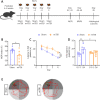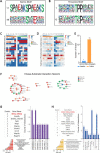Quantitative proteomic and phosphoproteomic analyses of the hippocampus reveal the involvement of NMDAR1 signaling in repetitive mild traumatic brain injury
- PMID: 37449635
- PMCID: PMC10358661
- DOI: 10.4103/1673-5374.374654
Quantitative proteomic and phosphoproteomic analyses of the hippocampus reveal the involvement of NMDAR1 signaling in repetitive mild traumatic brain injury
Abstract
The cumulative damage caused by repetitive mild traumatic brain injury can cause long-term neurodegeneration leading to cognitive impairment. This cognitive impairment is thought to result specifically from damage to the hippocampus. In this study, we detected cognitive impairment in mice 6 weeks after repetitive mild traumatic brain injury using the novel object recognition test and the Morris water maze test. Immunofluorescence staining showed that p-tau expression was increased in the hippocampus after repetitive mild traumatic brain injury. Golgi staining showed a significant decrease in the total density of neuronal dendritic spines in the hippocampus, as well as in the density of mature dendritic spines. To investigate the specific molecular mechanisms underlying cognitive impairment due to hippocampal damage, we performed proteomic and phosphoproteomic analyses of the hippocampus with and without repetitive mild traumatic brain injury. The differentially expressed proteins were mainly enriched in inflammation, immunity, and coagulation, suggesting that non-neuronal cells are involved in the pathological changes that occur in the hippocampus in the chronic stage after repetitive mild traumatic brain injury. In contrast, differentially expressed phosphorylated proteins were mainly enriched in pathways related to neuronal function and structure, which is more consistent with neurodegeneration. We identified N-methyl-D-aspartate receptor 1 as a hub molecule involved in the response to repetitive mild traumatic brain injury , and western blotting showed that, while N-methyl-D-aspartate receptor 1 expression was not altered in the hippocampus after repetitive mild traumatic brain injury, its phosphorylation level was significantly increased, which is consistent with the omics results. Administration of GRP78608, an N-methyl-D-aspartate receptor 1 antagonist, to the hippocampus markedly improved repetitive mild traumatic brain injury-induced cognitive impairment. In conclusion, our findings suggest that N-methyl-D-aspartate receptor 1 signaling in the hippocampus is involved in cognitive impairment in the chronic stage after repetitive mild traumatic brain injury and may be a potential target for intervention and treatment.
Keywords: Grin1; N-methyl-D-aspartate; N-methyl-D-aspartate receptor 1; cognitive impairment; hippocampus; learning; memory; phosphoproteomic; proteomic; repetitive mild traumatic brain injury (rmTBI); secondary injury.
Conflict of interest statement
None
Figures






Similar articles
-
Long-term cognitive impairment without diffuse axonal injury following repetitive mild traumatic brain injury in rats.Behav Brain Res. 2020 Jan 27;378:112268. doi: 10.1016/j.bbr.2019.112268. Epub 2019 Sep 30. Behav Brain Res. 2020. PMID: 31580914
-
Memantine improves outcomes after repetitive traumatic brain injury.Behav Brain Res. 2018 Mar 15;340:195-204. doi: 10.1016/j.bbr.2017.04.017. Epub 2017 Apr 13. Behav Brain Res. 2018. PMID: 28412305 Free PMC article.
-
Gamma frequency entrainment rescues cognitive impairment by decreasing postsynaptic transmission after traumatic brain injury.CNS Neurosci Ther. 2023 Apr;29(4):1142-1153. doi: 10.1111/cns.14096. Epub 2023 Feb 5. CNS Neurosci Ther. 2023. PMID: 36740277 Free PMC article.
-
Decoupling the mutual promotion of inflammation and oxidative stress mitigates cognitive decline and depression-like behavior in rmTBI mice by promoting myelin renewal and neuronal survival.Biomed Pharmacother. 2024 Apr;173:116419. doi: 10.1016/j.biopha.2024.116419. Epub 2024 Mar 13. Biomed Pharmacother. 2024. PMID: 38479178
-
Memantine Mitigates Oligodendrocyte Damage after Repetitive Mild Traumatic Brain Injury.Neuroscience. 2019 Nov 21;421:152-161. doi: 10.1016/j.neuroscience.2019.10.016. Epub 2019 Nov 1. Neuroscience. 2019. PMID: 31682950
Cited by
-
A comprehensive review of rehabilitation approaches for traumatic brain injury: efficacy and outcomes.Front Neurol. 2025 Jun 13;16:1608645. doi: 10.3389/fneur.2025.1608645. eCollection 2025. Front Neurol. 2025. PMID: 40584523 Free PMC article. Review.
-
High-altitude hypoxia aggravated neurological deficits in mice induced by traumatic brain injury via BACH1 mediating astrocytic ferroptosis.Cell Death Discov. 2025 Feb 5;11(1):46. doi: 10.1038/s41420-025-02337-8. Cell Death Discov. 2025. PMID: 39905004 Free PMC article.
References
-
- Apweiler R, Biswas M, Fleischmann W, Kanapin A, Karavidopoulou Y, Kersey P, Kriventseva EV, Mittard V, Mulder N, Phan I, Zdobnov E. Proteome analysis database:online application of interpro and clustr for the functional classification of proteins in whole genomes. Nucleic Acids Res. 2001;29:44–48. - PMC - PubMed
-
- Ayubcha C, Revheim ME, Newberg A, Moghbel M, Rojulpote C, Werner TJ, Alavi A. A critical review of radiotracers in the positron emission tomography imaging of traumatic brain injury:fdg, tau, and amyloid imaging in mild traumatic brain injury and chronic traumatic encephalopathy. Eur J Nucl Med Mol Imaging. 2021;48:623–641. - PubMed
LinkOut - more resources
Full Text Sources

